Contents
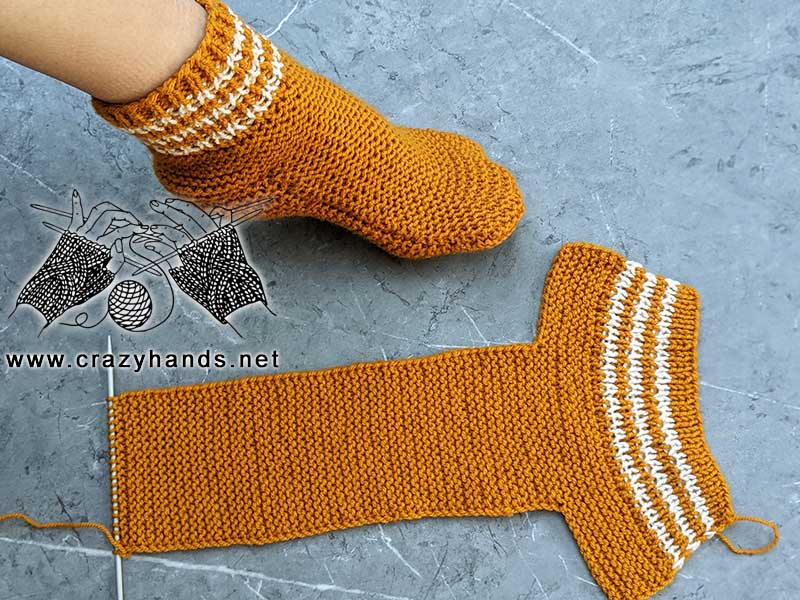
Knitting materials and knitting tools:
<> Circular or DPN knitting needles 3 mm (UK 11 or US 2.5);
<> Super Corfou (DK) – 100% acrylic 40 grams -95 m per skein;
<> Yarn or tapestry needle
Two-needle socks size:
Size: US7, EU 37
You can alter the size following thing simple calculations.
Size 7 = 24 cm sole
24/2 =12cm upper side
Length of the central part 24 +12 =36 cm, and to make the sock fit better 36 -2(3) cm = 34(33) cm
Gauge: 19-20 sts – 4 inches (10 cm)
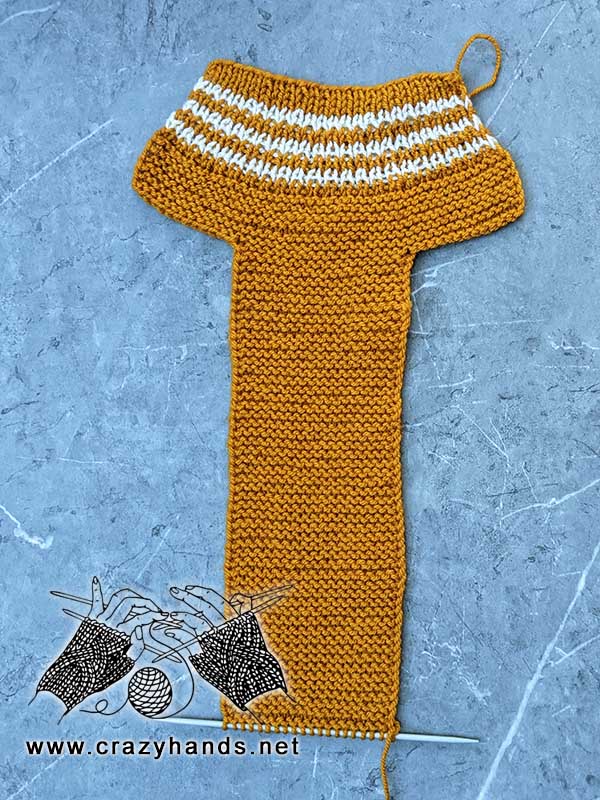
Common abbreviations of knitting stitches:
k – knit
p – purl
sel s – selvage stitch: always slip the first stitch purlwise, work to the last stitch, purl the last stitch.
Mattress stitch: pick up 1 or 2 bars right after the selvage stitch and pull the yarn through. On the other side, find opposing selvage stitch, pick up again 2 bars and pull the yarn through. Come to the other edge of your work, insert the needle into the same hole that the yarn came out from before and pick up the 2 bars again. Continue in this manner to the end adjusting the yarn tension as you go.
Two-needle flat socks pattern:
MAKE TWO.
Using yellow yarn color cast on 46. Please leave at least 15 cm tail, we will use it to stitch up a cuff.
Rows 1-3: sel s, [k1, p1] – repeat till the end, sel s.
Change yarn color from yellow to white. In the next round after you change color, always knit the first stitch instead of slipping it. Like this you will not have jogs when you start seaming up socks.
Row 4: k1, [k1, p1] – repeat till the end, sel s.
Row 5: sel s, [k1, p1] – repeat till the end, sel s.
Change the yarn color from white to yellow.
Row 6: k1, [k1, p1] – repeat till the end, sel s.
Row 7: sel s, [k1, p1] – repeat till the end, sel s.
Change the yarn color.
Row 8: k1, [k1, p1] – repeat till the end, sel s.
Row 9: sel s, [k1, p1] – repeat till the end, sel s.
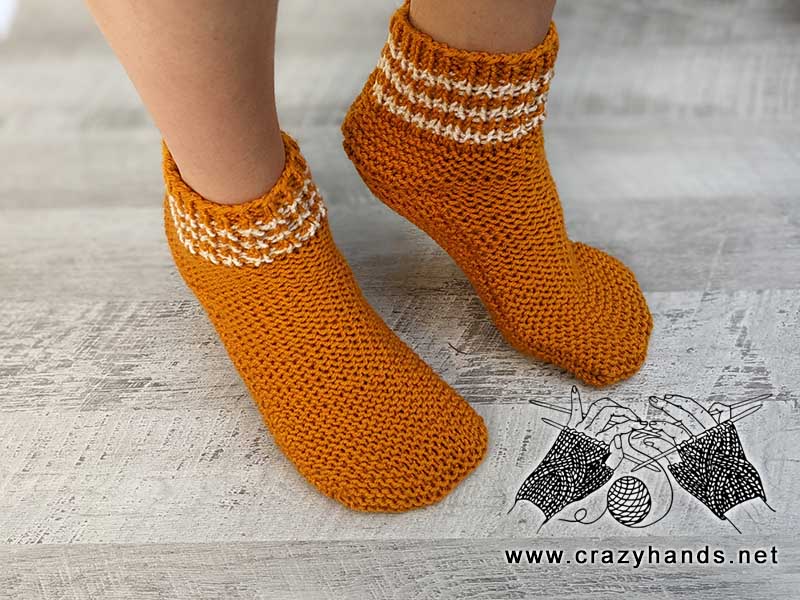
Change the yarn color.
Row 10: k1, [k1, p1] – repeat till the end, sel s.
Row 11: sel s, [k1, p1] – repeat till the end, sel s.
Change the yarn color.
Row 12: k1, [k1, p1] – repeat till the end, sel s.
Row 13: sel s, [k1, p1] – repeat till the end, sel s.
Change the yarn color.
Row 14: k1, [k1, p1] – repeat till the end, sel s.
Row 15: sel s, [k1, p1] – repeat till the end, sel s.
At this point ribbing part measures 6.5-7 cm.
Rows 16-29: sel s, knit all stitches, sel s.
Find 20 stitches in the center and place markers from both sides.
Row 30: bind off 13 sts, k32, sel s.
Row 31: bind off 13 sts, k19, sel s.
Row 32: sel s, k18, sel s.
Repeat Row 32 until central part reaches 33-34 cm (measure the length of the central part from the 32nd row, not from the 1st row).
Bind off all stitches. Cut the yarn leaving at least 15 cm tail.
Place the sock with the wrong side facing up, fold the central part, thread the tail through a yarn or tapestry needle, start stitching up the sock from one side using mattress stitch method. Cut the yarn.
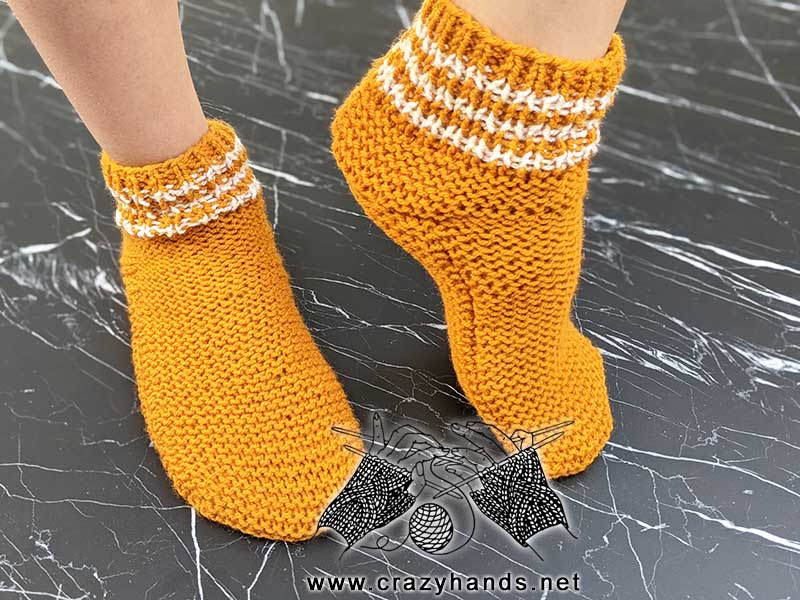 Attach new tail (20cm) and stitch up the sock from another part starting with toes. At the end do not cut the yarn and leave the tail to stitch up a heel. Thread the tail that we left at the very beginning and stitch up the ankle using the same method. Cut the yarn. Finally, stitch up the heel using the last tail. IMPORTANT, while sewing the heel at times you are going to insert the needle twice into 1 stitch at the bottom part. We are doing it because we have more stitches on the top than at the bottom and want to get a neat seam. Check the video if you have any doubts.
Attach new tail (20cm) and stitch up the sock from another part starting with toes. At the end do not cut the yarn and leave the tail to stitch up a heel. Thread the tail that we left at the very beginning and stitch up the ankle using the same method. Cut the yarn. Finally, stitch up the heel using the last tail. IMPORTANT, while sewing the heel at times you are going to insert the needle twice into 1 stitch at the bottom part. We are doing it because we have more stitches on the top than at the bottom and want to get a neat seam. Check the video if you have any doubts.
Cut the yarn and weave in ends.
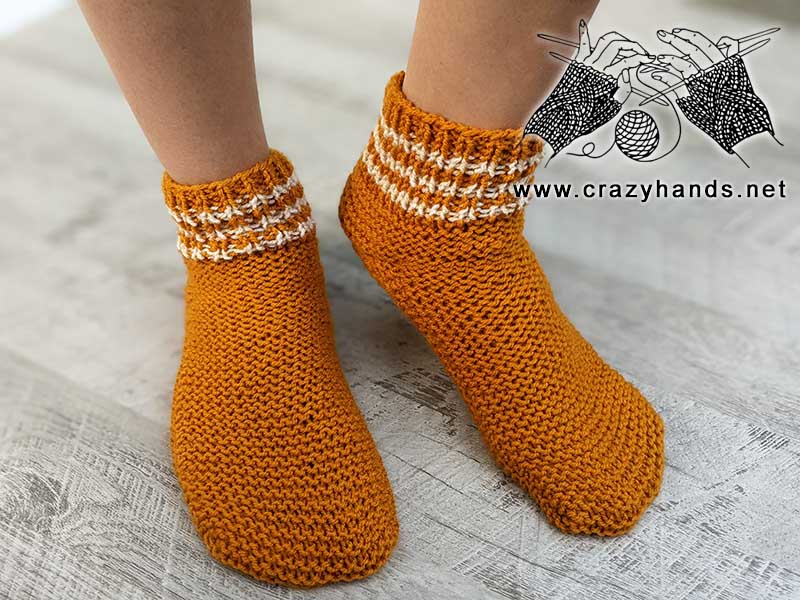


11 comments
Thanks for sharing your beautiful work with us. It’s so easy how you teach. I love how you teach. Thanks
such a lovely feedback. Thank you so much Sufia
If I want to use worsted weight yarn how many stitches would I cast on a d what size needle. Thank you
Hi. I have already tried knitting with worsted weight yarn. 3 mm knitting needles and i did not change the pattern at all. You will see this pattern soon on my channel. You can also try cast on 2-4 sts less if you see that gauge is differ a lot
How did you come up with casting on 46 stitches?
Thank you
Hi. I took medium measurements for an ankle that is equal 22 cm. My gauge 20 cm in 10 cm. 22*20 /10 = 44 sts. Added 2 extra to make the sock fit more comfortable but could actually work with 44. If you are going to use medium worsted yarn then cast on 44 or even 42 sts.
Thank you very much for this pattern! I knew that it had to be possible to knit socks, flat, on 2 needles but I couldn’t get my head wrapped around HOW. I’m so glad I found this pattern. Now I can knit socks without fiddling around with double pointed needles. My mother was always knitting mittens on 4 needles and wanted me to take up that activity as a child but I found the process irritating because it seemed that needles were always flopping around so I abandoned the process entirely. ( I know, bad attitude, no patience) I knit mittens on two needles and have done so for years, but now I can graduate to socks. 🙂 Thank you for your generosity in sharing this pattern.
Thank you for you warm feedback! Good luck with your first socks :)!
I have a book entitled Knit Your Socks on Straights, by Alice Curtis. I made a pair and they turned out very nice. But it was not a fast process.
I knit faster on my long straight needles than I do on dp’s. I am very slow on the circulars. I like your sock pattern and will try making the sole of the sock thicker using 2 strands of yarn. Thank you for your patterns.
Oh, really good idea about 2 strands for the sole. And I am happy you like the patteern!
Brilliant!!